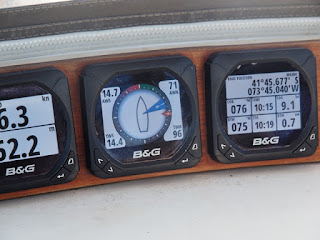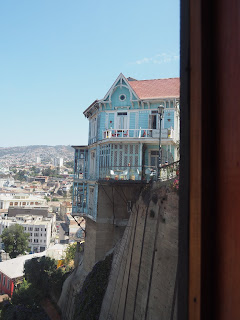My very first impression upon sailing into Valdivia, Chile
last March after our passage from Easter Island, was ‘wow, this looks so much
like BC’.
That initial thought has
repeated itself in my head over and over again as we sailed south from Valdivia
and into northern Patagonian waters.
 |
| Typical view looking east from Isla Chiloe |
The
general topography is similar to BC.
There is a huge 190 km long island called Isla Chiloe (similar to
Vancouver Island) that protects a big open straight (similar to Georgia Strait)
that contains many small, protected islands (like the Gulf Islands). There is then an open body of water (crossing
from Port Hardy around Cape Caution) to a massive archipelago of islands where
you could literally get lost for years.
 |
| Who is winning? Seaweed 1, Gary 0. |
But, as we looked a bit closer, we began to see the
differences.
For example, the islands off Isla Chiloe, which look
strikingly similar to the Gulf Islands at first glance, are not full of
tourists. They are inhabited by people
who have lived and farmed there for generations. While the odd foreigner makes the trek to the
islands, the vast majority of visitors seem to be family of people that live
there. Unlike the Gulf Islands, there
are very few cottages for wealthy “city people”, and the islands have a quaint,
quiet vibe of people just getting on with their lives. We visited the tiny island of Quehui
(pronounce Q-E) and anchored in from of the town of 800 people. Upon arriving on the beach in our dinghy, we
were instantly welcomed (accosted?) by Ignacio and his brother Patricio who run
a small café (from the living room of their house) that doubles as the tourist
office. While Ignacio didn’t speak a
word of English, Patricio was learning and so we managed a stilted conversation
about life on the quiet island. Unfortunately
his English was about as good as our Spanish, but we appreciated their hospitality
and interest. They encouraged us to
return the next day for a lunch of “loco”, which turned out to be giant snail
foot, served with lime and mayonnaise on top of a tomato. Sounds weird, but it is apparently a delicacy
that can only be found in southern Peru and Chile and is quite special. It was actually pretty good and an experience
unique to southern Chile.
 |
| Dr Suess tree |
Another major difference is the flora and fauna. While the landscape looks similar (rustic
tree-filled mountains), the kinds of trees are completely different. Instead of impenetrable groves of douglas
fir, hemlock and lichens, here there are impenetrable jungles of Cypress,
Laurel, Beech, Gunnera (looks like giant rhubarb), tree ferns, tussock grass and
lichens.
 |
| Peale's Dolphins leaping for joy |
The animals are different as well. While the South American Sea Lions are
curious like in BC, they are HUGE and have enormous manes. Nothing gets the heart pumping faster than
looking behind your sea kayak and seeing six of them tailing you…
Pods of the
beautiful Peale’s Dolphin have visited us to play in our bow wave several
times, and we were extremely lucky to see a rare Marine Otter (only 1000 left),
which is smaller than its’ northern cousin but eats dinner on its’ tummy just
the same.
 |
| The rare Marine Otter |
 |
| Imperial Cormorants |
We are constantly seeing new kinds of birds, which keep us
running for our identification book. So
far we have sea kayaked with Magellanic Penguins, watched Flightless Steamer
Ducks running across the top of the water, been delighted by the antics of the
black and white Imperial Cormorants, and been amazed by the Kelp Geese, where
the male is all white and the female is predominantly black and brown. The hummingbirds still go for lovely pink
flowers like they do at home, but here they are the size of sparrows. And then there are the Albatross. Almost every day we have been entertained by
watching these majestic beings soaring above the waves. Watching them has saved my sanity more than
once.
It is still early days for us in our exploration of this
lovely country. The familiar
surroundings make us feel comfortable and at home, while the differences are a
delight to discover.
























